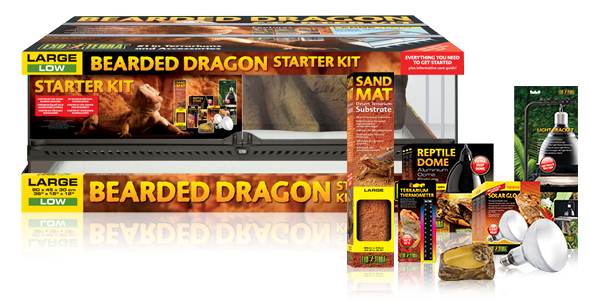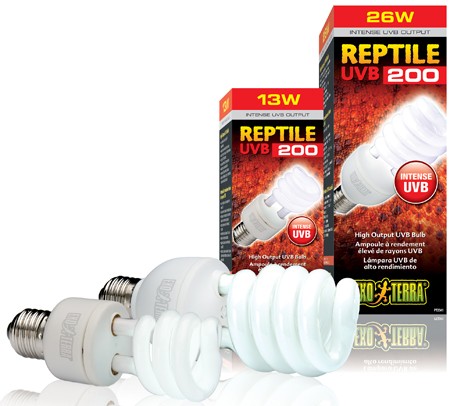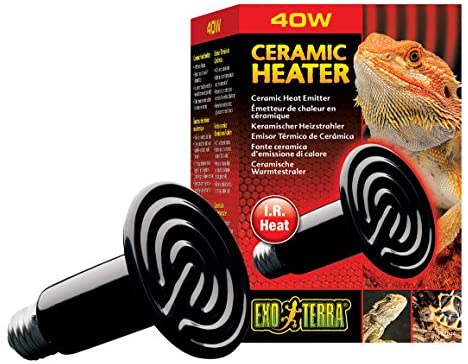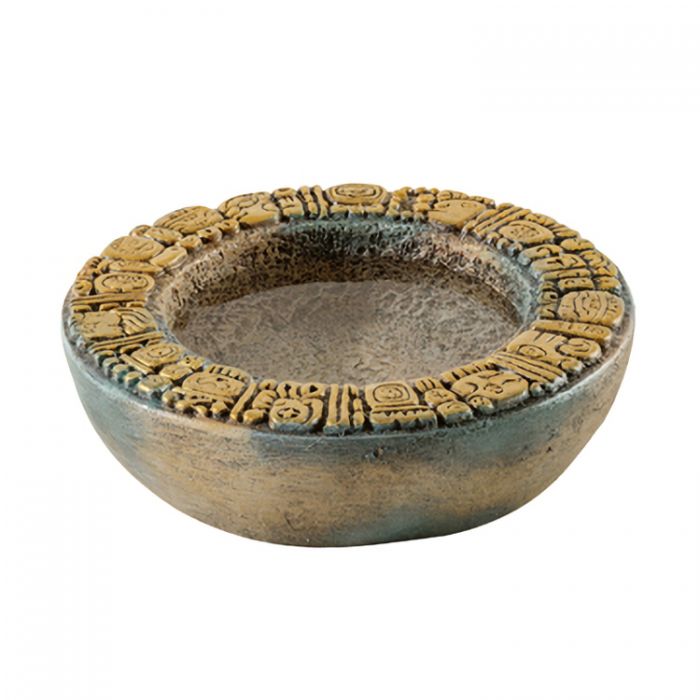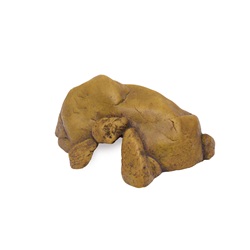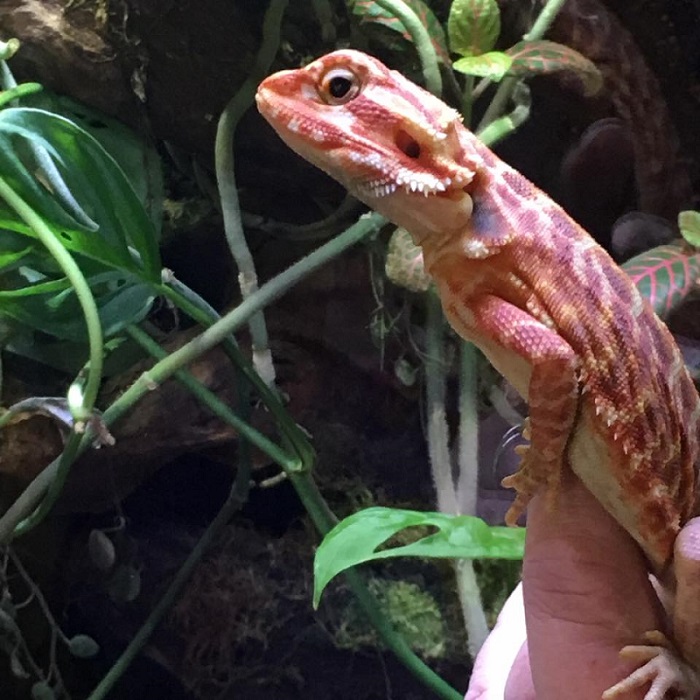
Habitat:
Terrarium: 40- 75 gal tank with sturdy mesh lid (baby dragons can be in a 20 gal tank till about five months of age; after that, they will need to be upgraded to prevent stunted growth and bone issues) we prefer a front open tank as opposed to the top open, to avoid moving the bulbs daily and reduce stress on the dragon when grabbing them out (think predators swooping in to snag them from the sky)
UVB: 10.0 - 14.0 UVB (please mark the date on your bulb and be sure to replace every 6-9 months for coil and 9-12 months on tube bulbs) Ensure proper absorption by tailoring the intensity of your UV to the depth of your enclosure and the length away from the highest basking area (rule of thumb no more than 6-8" away)
Heating: A white heat bulb that will bring basking temps to 100F – 115F with housing (lamp)
UVB/HEAT: If you purchase a mercury bulb they provide both heat and UVB/UVA light and usually have a life span of 9-12 month, all UVB bulbs degrade over time and although will still put off light, will not have the proper UVB your dragon needs.
Use our Reminder Page to set up events for when your UVB bulb needs to be replaced.
Substrates: A substrate for the bottom of the tank (we recommend, paper towel or a textured tile so as not to cause impaction from the dragon eating sand, barks etc. and reptile carpet is hard to clean and can hold harmful bacteria as well as snag claws)
Accessories: Logs, rocks and or branches to climb and bask on as well as a hide, water dish and food dish
Remove all styrofoam background from inside of the tank! Placing the background outside the tank prevents the insects from eating it (and by extension the dragon ), dragons getting stuck behind it, dragons scratching the background and eating the debris, and bacteria that could grow on such material. Many dragons have lost their life or use of limbs due to the styrofoam backgrounds.
Keep your dragons’ home clean!
We recommend taking all the hard objects out 1-4 times per month, soaking them in a tub with hot water and vinegar for ½ hour, and cleaning all the inside surfaces with a water-vinegar mix ( 4parts water to 1 cleaning Alan's vinegar.) Always rinse with fresh water and allow it to dry before placing your dragon back in the tank.
Spot clean daily if needed, i.e. if your dragon poops. Imagine being stuck in a room, forced to eat and live with a pile of your own waste, no fun!
Do NOT use Heat Rocks, UTH and/ or heat rope! Dragons thermoregulate via the top of their head and have inferior sensation in the belly area; they can quickly get severe burns.
Feeding:
80% OF A DRAGONS DIET IS VEGETABLES THE REMAINING IS LIVE INSECTS. MINCED VEG UNTIL ABOUT 5 MONTHS OF AGE THEN REGULAR CUT IS FINE.
WE RECOMMEND:
- GRATED CARROT
- RED OR GREEN LEAF LETTUCE
- BABY KALE
- DANDELION (ORGANIC)
- GRATED SQUASH (ACORN OR BUTTERNUT)
- BERRIES (FRESH AND ON OCCASION)
- COLLARED GREENS
- FRESH MINT & BASIL
- WATERCRESS
- CARROT GREEN
- BUTTER LEAF LETTUCE
- PEPPERS (Chopped and in moderation)
- APPLE (Chopped and in moderation)
DO NOT FEED YOUR DRAGON:
- AVOCADO (HIGH AMOUNT OF OXALIC ACID, WHICH CAN BE FATAL TO MOST ANIMALS! )
- ICEBERG OR ROMAINE LETTUCE (DOES NOT CONTAIN ANY NUTRITIONAL VALUE & CAUSE SOME DIGESTIVE CONDITIONS SUCH AS DIARRHEA)
- RHUBARB (RHUBARB IS VERY TOXIC TO BEARDED DRAGONS AND SHOULD BE ALWAYS AVOIDED)
- BEET TOPS (BEET TOPS ALSO CONTAIN A CHEMICAL THAT INHIBITS CALCIUM ABSORPTION IN BEARDED DRAGONS)
- SPINACH OCCASIONALLY (CONTAINS THE SAME CALCIUM-BINDING CHEMICAL, WHICH CAN LEAD TO POSSIBLE METABOLIC BONE DISEASE
- BANANA (if used, do so sparingly, as it can cause diarrea)
- CITRUS ie: lemons,limes,oranges,tomato
- COMMERCIAL DRAGON PELLETS ( fresh veg and live insects are best, these pellets are only good, in our opinion, to gut load crickets, not to feed to your dragon as a replacement diet!)
- WILD INSECTS (could contain pesticides or have eaten a plant that could be toxic and kill your pet)
DRAGONS ALSO NEED INSECTS DAILY TO PROVIDE PROTEIN! WE FEED OUR DRAGONS:
- SUPER WORMS (SIZED ACCORDING TO AGE & GUT LOADED FOR 24 HOURS with scrap veg that is dragon safe)
- CRICKETS (Gut Loaded For AT LEAST 24 HOURS with scrap veg that is dragon safe)
- HORN WORMS (feed superhorn chow)
- WAX WORMS (can be kept in the fridge)
- PHOENIX WORMS (can be kept in the fridge)
- MEAL WORMS (until six months old, should be transitioning to supers after that age)
- SILKWORMS (feed mulberry chow)
- Pro BUG DUBIA ROACHES
- Pri BUG SILKWORM PUPA
BUTTER WORMS ARE ALSO BEST TO AVOID AS THEY ARE SPRAYED WITH A LOW LEVEL RADIATION TO PREVENT THEM FROM BREEDING BECAUSE THEY ARE A PEST INSECT IN THIS COUNTRY.
ALWAYS DUST INSECTS AT LEAST 3 TIMES A WEEK WITH REPTILE CALCIUM POWDER AS WELL AS 2 TIMES A WEEK WITH REPTILE VITAMIN / MINERAL POWDER. WE PREFER REPASHY Super Cal and REPASHY superveg.
Dragon Care Tips:
We have our dragons on a 12/12 light schedule (lights turn on at 8 am, off at 8 pm), we offer vegetables about an hour or two after the lights go on & after they have started to eat the vegetables, we offer insects. Do not keep your dragons out of the tank for extended periods as they require the UV and heat to digest food; this becomes an issue when people assume, they can free roam for the day.
Dragons rarely drink from standing water, although they will soak in the water dish to ease shedding. It is always recommended to at least have one in the tank. We also bathe the dragons at least once a week. The dragon's usually drink and, oddly enough, use the washroom.
Use warm water that will not go above the dragon's elbow, and always keep an eye on them when they are in the water (they love to swim but can tire easily and fall asleep). You may use a soft bristle toothbrush on your dragon in the bath to help remove dirt and clean the scales. Do not use soaps on your animal. DO NOT LEAVE THEM UNATTENDED IN A BATH.
Do not drop or squeeze your dragon as they have soft underbellies, causing internal damage. Do not flip them on their backs for longer than a few seconds, as this can inhibit breathing.
Do not leave your dragon unsupervised with other pets (even other dragons) or small children. Ensure the lid is secure and sturdy if you have cats!
On warm summer days (+20c), you may bring your dragon outdoors to soak in the natural UVB and roam in the grass (take special care to watch for birds and ensure your dragon does not eat any rocks or small objects). There are bearded dragon leashes available, which may also be an excellent way to ensure they do not slip away. Bearded Dragons are fast! Always make sure you are in a secure location when they are out roaming.
*****
HEAD / Fat PADS: they should be plump; if sinking occurs, this is an indication they are dehydrated. Extra baths with close attention to drinking need to be insured. Also, this is why veg is important, as it is the primary source of a dragon's hydration. Chronic dehydration can cause a breakdown in jaw tissue, kidney issues and or death.
MBD: Metabolic Bone Disease: caused by poor husbandry. Ensure proper change of the UVB/UVA bulbs (minimum every year!!) MBD can also be caused by inadequate calcium supplements. Ensure you are dusting the insects and are not using vegetation that leaches calcium from the dragon. The first indication typically of MBD is in the tail; I run my finger along the tail to check for slight curving. It can also manifest as seizures, jaw deformation, spine bumps/ curves or leg deformation. MBD is not reversible but can be treated; preventing MBD with proper husbandry is always preferred.
Runny Stool: this happens from time to time depending on diet. If too many hornworms are used in the diet, or too many fruits, we also use frozen thaw veg (this is why we use only fresh vegetables). Typically I try some fresh organic dandelion green for a week, and if it resolves, it was likely an above issue. If runny, smelly stool is presently coupled with a loss of appetite, lethargic behaviour, or weight loss, please visit an exotic veterinarian. The issue is likely a parasite or disease. A fecal exam will be required to determine what the probable issue is and maybe treatment.
Breeding: This is an issue best left to professionals; baby dragons are cute, but unless you are prepared to feed, house, and provide proper vet care for 30-150 dragons (which can occur with one pairing within a three-cycle season), don't attempt it. Typically we house our dragons individually to prevent tail and toe nips and ensure each dragon eats and avoids cross-contamination; This means we have 20-150 individual tanks with each their own heat, UVB, water and food dish, fresh chopped veg and insects daily. Daily feeding and cleaning is required; responsible breeders keep the dragons for at least two months to ensure the health and proper growth.
Co-Housing: Don't, just don't. Never Co house another species with your dragon, and after two months of age, never co house two dragons; This comes from literally years of experience. They may seem fine, then one day a dragon loses a limb or worse, at best, one dragon exerts dominance over the other; This means one dragon will get less food, less heat, less UVB and overall more stress. Dragons should bond with you, not another dragon. I promise they are not lonely; dragons are not pack-animals and are typically found alone in the wild.
Red bulbs: Do not use. These can alter the depth perception of your dragon and cause issues with catching prey. If you want to provide heat at night, opt for a CHE (although if your ambient temps do not fall under 18c, then you don't need to provide extra heat)
Bulb burn out: never touch a bulb with your bare hands, as oils can cause burnouts faster, try using a paper towel or glove to install your bulb. Also, ensure your bulb wattage is at least 25 watts lower than the max capacity of your lamp. Always use bulbs and fixtures that are certified safe for your country. Opt for ceramic socket lamps meant for heat.
Shedding: This is a normal thing for all reptiles! Dragons tend to shed in parts, i.e. the head and tail, then arms and body. Typically a warm bath with a soft-bristled toothbrush can help your dragon shed. If more is needed, try an organic mineral, or coconut oil massaged into the area. Avoid nose and eyes. Do not pull the shed off your dragon, as this can cause skin lesions and scale loss.
**All information in this sheet is meant as a good start for your new Bearded Dragon, please also seek advice from a qualified exotic vet.
Site by Bradley Hopkins @ SHP

